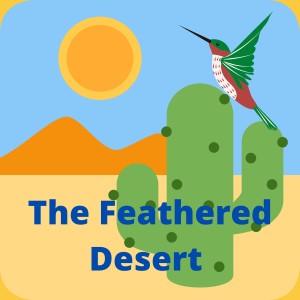
11K
Downloads
144
Episodes
Backyard bird feeding is one of the most enjoyable and rewarding hobbies on earth. Join Cheryl and Kiersten as they talk all about bird feeding in the desert Southwest area of the United States. They talk birds, seed, feeders, and dealing with those pesky unwanted visitors!
Episodes

Monday Jul 24, 2023
Unusual Eats
Monday Jul 24, 2023
Monday Jul 24, 2023
Summary: “You eat like a bird!” We’re sure you’ve heard this before and may have even said it, but if you knew what we know, you’d probably never say it again! Join Cheryl and Kiersten as they talk about some of the strange things birds eat!
For our hearing impaired listeners, a transcript of this podcast follows the show notes on Podbean.
Show Notes:
“Cassowaries: Crucial to Rainforest Ecology,” The University of Waikato, https:blog.waikato.ac.nz/bioblog/2009/12/cassowaries-crucial-to-rainfor/
American Bird Conservancy, https://abcbirds.org
Our email address, please reach out with comments, questions, or suggestions: thefeathereddesert@gmail.com
Cheryl: Intro
Have you ever heard the expression “You eat like a bird.” What did that really mean? I personally never got it, but I heard many times. If the person who coined that phrase really knew what birds ate, I don’t think that it would have been said at the dinner table. Today let’s look at the weird things’ birds eat and a little about how they do it.
So, there’s the Phainopepla that consumes mistletoe berries, and a lot of them; this bird can do this because they have a specialized digestive tract to accommodate this particular berry. Then there is the American Robin, that changes it digestive system to be able to adjust to the transition from protein-rich invertebrates in spring and summer to fruits and berries in winter.
Kiersten: Worm-Eating Warbler
This warbler is small, rather drab in color with a black and buffy head stripes on its flat head. This flat head helps it to get into all the nooks and crannies of the forest floor where it consumes caterpillars and slugs, insect larvae but not earth worms like the name suggest. This warbler has a beautiful song that helps it live up to the warbler part of its name even if its drab in color.
Cheryl: Shore birds and Sapsuckers
Birds like the Black-necked Stilt, and the American Avocet are shore birds that eat mollusks such as clams, oysters, snails, and slugs found in the muddy water along the edges of creeks, rivers, lakes, ponds and irrigated fields and agricultural fields.
Then there are birds that feed on the mucus of plants and trees, namely sap. These birds are woodpeckers, waxwings, kinglets, and warblers which all have a component of sap/mucus in their diet.
Kiersten: Red-tail Hawk and Great Horned Owl
Rattlesnakes and Red-tail hawks, two very capable predators, but if an adult red-tail hawk locates a rattlesnake out in the open, it’s a dead snake crawling. Rattlesnakes are a favorite meal for this hawk. Red-tail hawk doesn’t sneak up on a rattlesnake, if it did that it would actually give the rattler the advantage. Instead, the hawk flies down and perches right in front of the snake. There by taking the lead in what is often called the “dance of death.”
- The hawk will fan out its feathers, exhibiting its 5 ft wing span.
- In response, the rattlesnake will rattle it’s tail in a warning, and will puff up to look bigger and more formidable. This might work.
- If not, the hawk will then hop or walk around, essentially trying to divert the snake’s attention.
- This will likely trigger the rattlesnake to snap open its mouth and display it 5-7” long fangs, and with the coiling motion, it will lunge forward.
- Then the hawk hops onto the snake and end the snake’s life. Red-tail hawks don’t eat the head of the snake therefore avoiding ingesting any venom.
Great Horned Owls have excellent night vision and a poor sense of smell, which helps it deal with one of its favorite meals- skunk. So, when you are out in the wilds of Great Horned Owl habitat and you smell skunk, but don’t see one you could be in the area of a Great Horned Owl nest.
Cheryl: Scott’s Oriole and Western Tanager and the Cassowary
Scott’s Oriole is a fruit eater, not only do these birds eat dagger cactus fruit, but also cultivated fruits such as apricots, peaches and figs. The Western Tanager lives off of insects such as bees and wasps in the spring and summer. Then in the winter months it will enjoy berries…all kinds like hawthorn, wild cherries, elderberries, blackberries, mulberries and service berries.
All the above-mentioned birds may be found in our state of Arizona, but there is one fruit eater that lives in Australia and Papua New Guinea, the Cassowary. This bird is the third largest bird in the world with an adult standing up to six feet tall. These birds live in the rainforests and are considered keystone species because of their role as a major seed dispenser of up to 238 rainforest plant species. Over a 100 of these plants’ species depend entirely on Cassowaries to dispense their seeds.
In some cases, cassowaries are the only bird to be able to digest the fruit of certain plants such as the Cassowary Plum. This fruit contains a sap that is poisonous to humans and most other animals.
The Cassowary’s unique digestive system which is short and fast, to digest the fruit. The Cassowary plum is an important food source for the Cassowary, and in turn the bird than distributes and helps germinate the seeds of the plant.
Cheryl: Closing
Now doesn’t this make you think twice about that old expression” You eat like bird”. Really do you?

No comments yet. Be the first to say something!